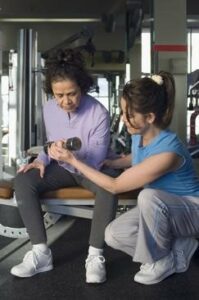 Physical therapy is essential to maintain mobility and help seniors retain their independence. Physical therapists employ a wide range of techniques to promote mobility, reduce pain, and restore functional movement. They work in a variety of settings and their services generally are covered by health insurance, including Medicare.
Physical therapy is essential to maintain mobility and help seniors retain their independence. Physical therapists employ a wide range of techniques to promote mobility, reduce pain, and restore functional movement. They work in a variety of settings and their services generally are covered by health insurance, including Medicare.
Physical therapists use a number of different methods to accomplish their goals. Treatment typically starts with a thorough evaluation to determine the best treatment for your individual needs. Treatment may involve hydrotherapy, heat therapy, electrical stimulation (“e-stim”), and the most common, manual therapy. Hydrotherapy involves the use of hot or cold water to treat different ailments. Pools are a great way to get exercise and therapy without putting extra stress on your joints. It offers gentle resistance and slow controlled movements to improve your mobility and lessen or manage your pain. Heat therapy and e -stim use heat or a gentle electric current to ease muscle strain, stiffness, and the effects of overall conditions such as fibromyalgia. In manual therapy, therapists use their hands to manipulate your muscles, tendons, ligaments, and joints to improve mobility and function.
Most physical therapy goals for seniors involve reducing pain and swelling in order to make daily tasks easier. This, in turn, helps make you more autonomous and comfortable doing what you love. Some common conditions in which physical therapy are especially valuable include:
Arthritis
(which we discussed last week link): The Centers for Disease Control reports that physical therapy can help maintain and restore balance, coordination, and strength. It will also help relieve your joint pain and prevent further injuries.
Stroke
Many different types of therapy are needed after one has a stroke. Physical therapy typically focuses on restoring lost function, while other treatments, such as occupational therapy and speech therapy, are used to help learn new ways to perform daily activities.
Osteoporosis
This condition can lead to broken bones after falls, according to the National Institutes of Health. As you age, your bones may become frailer. A physical therapist will help you learn weight-bearing exercises to rebuild your bone mass and density.
Incontinence
Physical therapy may be able to help you strengthen the muscles of your pelvic floor and torso in order to regain control, according to the National Institute of Diabetes and Digestive and Kidney Diseases.
Physical therapy can greatly improve your quality of life and allow you more freedom to enjoy your everyday activities. There are many exercises you can even do at home to help increase your strength and improve your balance. It is recommended, however, that all exercises be supervised initially to ensure they are done properly. Once you are accustomed to the movements and feel comfortable doing them without assistance feel free to do them anytime you want! Here is a wonderful collection of how-to videos by 24Hr HomeCare that will help get you started. Some of other simpler movements include:
Toe the Line
Place one foot in front of the other, so that your heel touches the toes of the other foot. If you can’t bring them completely together, it’s no problem! Just do the best that you can. Alternate feet slowly across the room in a straight line.
Flamingo
Hold onto the back of a chair, then lift one leg. Carefully extend your lifted leg in front of you. Maintain this position for 10-15 seconds, or as long as you can, before switching to the other foot. Maintain a good posture while doing this technique. Once you can do this exercise easily, challenge yourself by trying to touch your outstretched toes as well.
Leg Raises
Hold onto the back of a chair and try to raise your leg towards the back, without bending your knees. Stay in this position a few seconds, then switch to the other leg.
Wall Push Ups
Just like regular push-ups, except on a wall! Stand about arm’s length from a wall. Place hands on the wall and bring your chest down to the wall. Then straighten your arms back out, lifting your chest up to starting position.
Generally, it is a good rule to begin by doing 5-10 repetitions of each exercise, every other day. Once you feel confident and that becomes easy, move onto 10-15 repetitions. It won’t be long before you start to notice big differences in your ability to perform everyday activities.

